Digital channels have exploded, and so have customer issues. Businesses now use automation to scale their teams, resolve customer issues faster, and drive customer engagement.
One such capability that is gaining a lot of attention is an intelligent virtual agent (often referred to as a virtual agent).
You may know about chatbots, bots, and intelligent virtual assistants that automate workflows but are still confused about the difference.
We’ll set the record straight on intelligent virtual agents, what they can do, noteworthy benefits, and how innovative companies are using them.
What Is an Intelligent Virtual Agent (IVA)?
Intelligent virtual agents, also called virtual assistants, are AI-powered software that mimic human conversations to interact with customers.
Unlike traditional chatbots, which are limited to pre-programmed responses, IVAs use natural language processing (NLP) and machine learning to understand the context of customer queries and enable more personalized and natural interactions.
IVAs can handle complex questions, check multiple data sources, and tailor responses to the context of the conversation.
Even though virtual agents are occasionally confused with chatbots, they’re significantly more advanced.
Virtual agents offer a crucial service layer for many businesses. IVAs provide a better customer experience than traditional chatbots and can resolve a customer’s issue faster.
By lowering the number of customers who require live operator assistance, IVAs can resolve inbound contacts faster and improve a customer’s experience.
Omnichannel solutions based on intelligent virtual assistants (IVAs) integrate messaging apps, SMS, and social media platforms into a single unified platform, streamlining customer support across multiple channels.
Situational awareness: Intelligent virtual agent vs. chatbot
Chatbots and virtual agents are conversational AI tools that provide customer support, but they have different capabilities and offer different levels of customer experience.
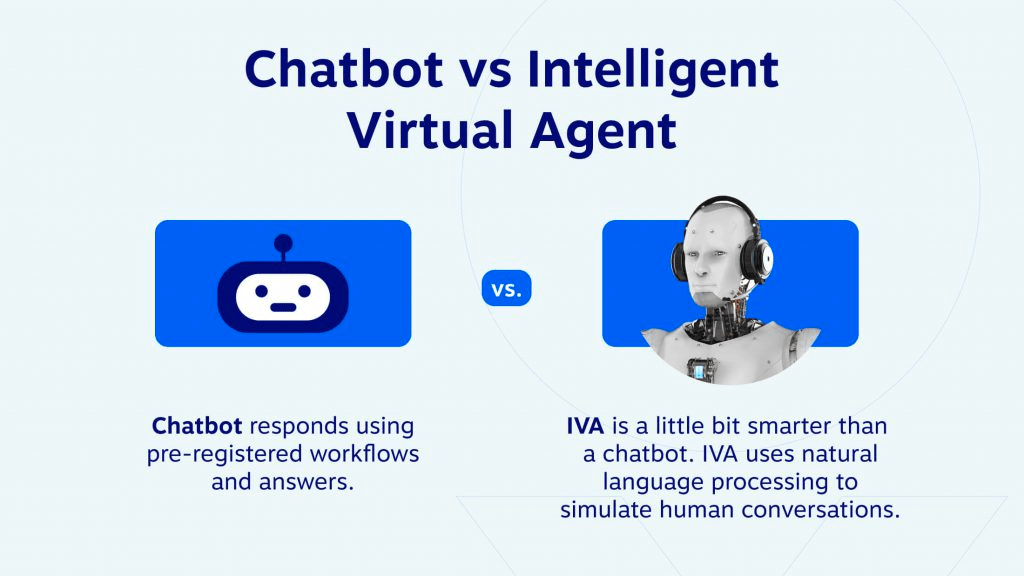
Chatbots are relatively simple and typically used to answer basic questions or provide links to relevant information. They follow pre-programmed rules and cannot understand the context of a conversation. In addition, a simple chatbot can, at most, offer pertinent articles from a knowledge source.
Virtual agents are more sophisticated, using AI technology and natural language understanding (NLU) to simulate human speech, understand customer intent, answer real-time queries, better grasp user language, and offer more personalized responses. You can also ask follow-up questions and forward chats to human agents if necessary.
Here’s an example of how a chatbot and virtual agent would respond to the same customer query:
Question: “I would like to extend my subscription.”
Chatbot response: “Please visit our website to renew your subscription.”
Virtual agent response: “I noticed your service is due to expire next month. Do you want to renew it?” I can renew your subscription here or connect you with a live agent.”
Query: “I’d like to renew my subscription for the next six months.”
Chatbot will typically search the knowledge base for the term “renew subscription” and present an article outlining how to renew a subscription. IVA will ask about the subscription plan, submit a request for a subscription, and will also attempt to upsell.
As you can see, the virtual agent can understand the context of the customer query and provide a more helpful response.
Benefits of Using Intelligent Virtual Agents
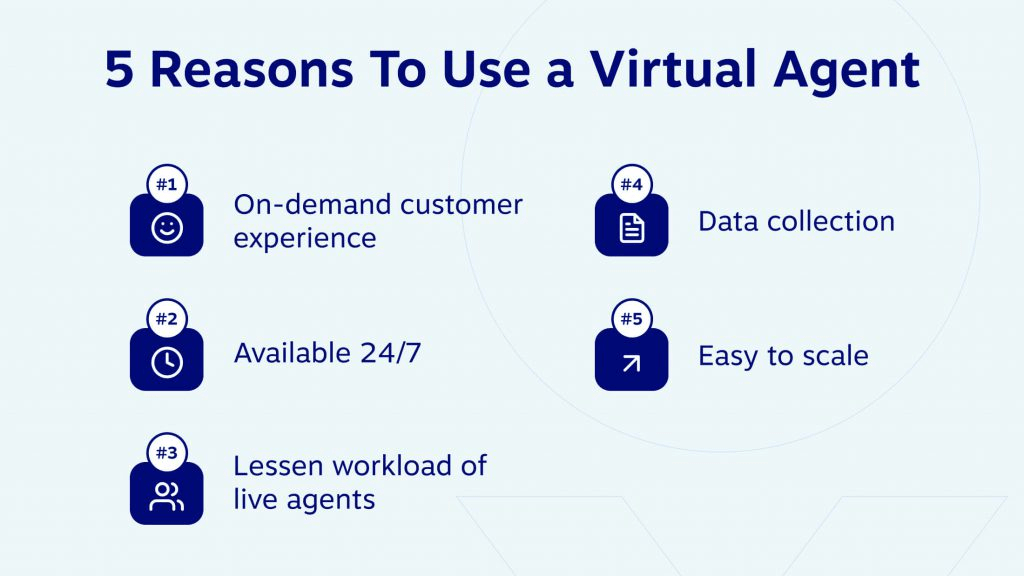
IVAs offer a variety of benefits for businesses including:
- Improved customer experience. Intelligent virtual agents offer a human-like experience that can instantly assist customers in finding a solution. These tools automate tasks such as answering FAQs and routing inbound calls to the right agent.
- 24/7 availability. Since virtual agents can respond to most typical inquiries, this effectively scales your team after hours and saves employee billable hours.
- Improved efficiency. IVAs help deflect customers from email, phone, and live chat in favor of artificial assistants. This ensures that agents directly assist customers with particular needs or sensitive situations that call for a personal touch whenever agents are on the phone.
- Data collection and insights. Virtual agents are an excellent way to amass actionable data collection since they converse via text. Analyzing this data and other applications of AI and natural language processing can produce valuable insights.
- Scalability and cost-effectiveness. A good combination of virtual agents for repetitive tasks and support agents to manage inquiries that need human assistance can lead to better returns and a more sustainable business expansion plan.
Use Cases for Intelligent Virtual Agents
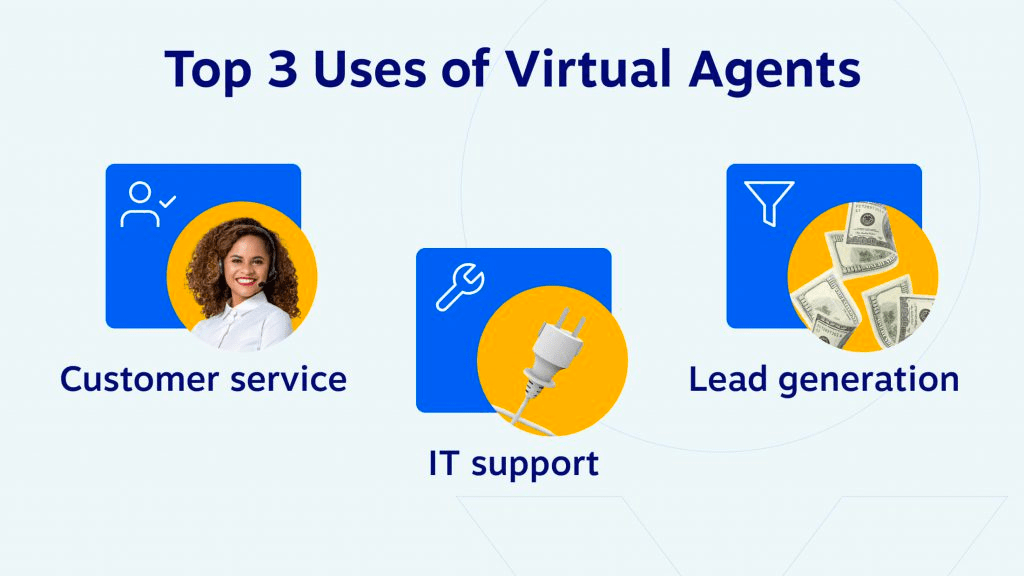
Customer service
Virtual agents are a wonderful addition to any customer support team, but that does not mean they should take the place of your live chat agents.
Many of the inquiries that customer service agents deal with are somewhat routine, for example:
- How do I renew my subscription?
- Do you give discounts on orders?
- How do I update my account details?
A virtual agent can respond to all of these questions instantly, and responses are more convincingly natural – thanks to conversational AI. As a result, routine inquiries won’t require a team member to respond to them via email or hold a lengthy phone call. The virtual agent handles their resolution instead.
Lead generation
Your sales and marketing teams can benefit from virtual agents and chatbots by using them to help generate leads. They offer a fast way to gather user data and determine their intentions.
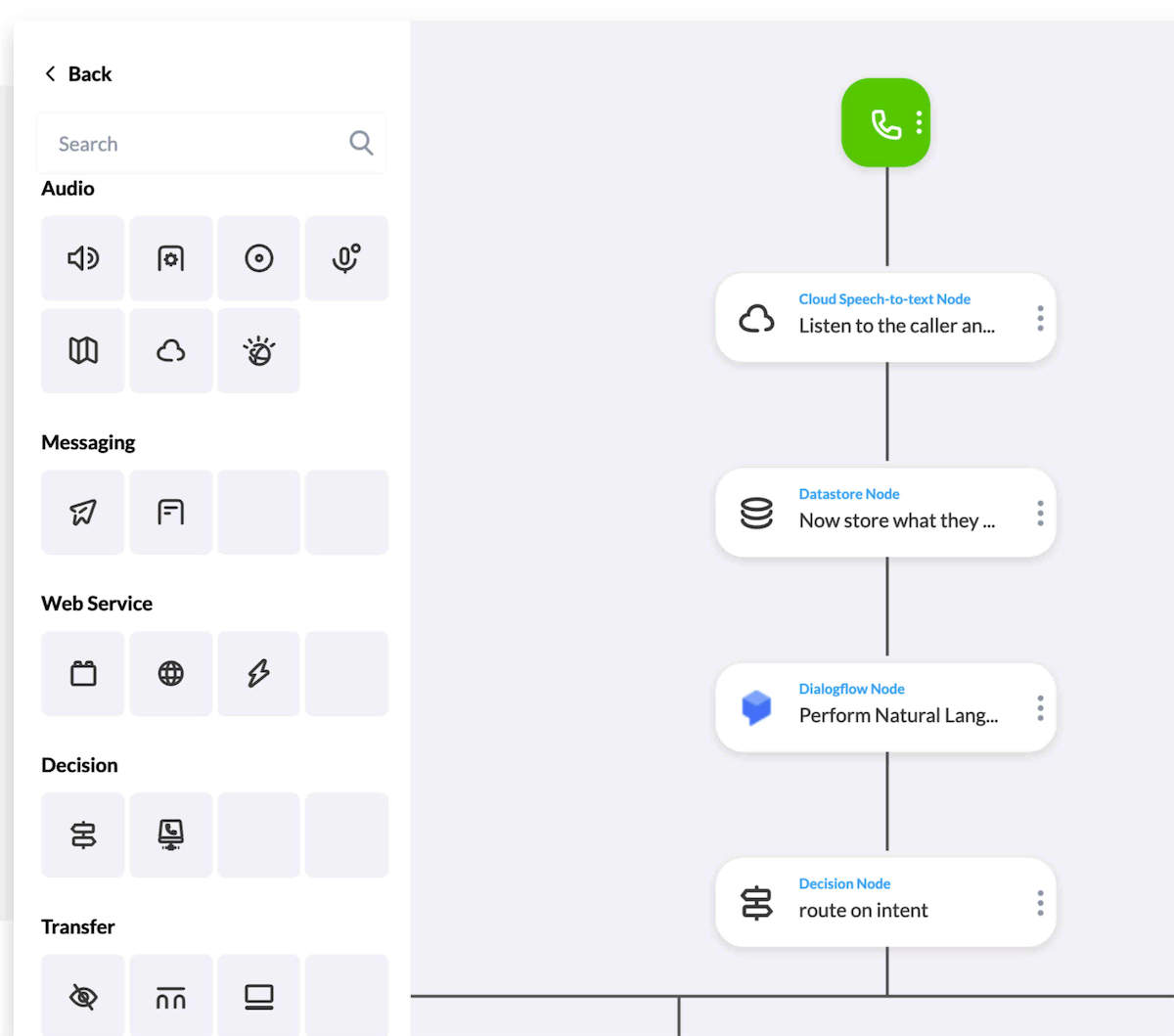
With a virtual chat agent in place to take information like email, name, and reason for contacting, your salespeople have enough detail to begin chasing leads.
IT support
An IT helpdesk will have to handle a lot of repetitive requests, just like customer service. A virtual agent can handle software updates, password resets, and simple troubleshooting tasks.
A virtual agent or simple chatbot can collect information and generate a ticket even for more complex inquiries.
Examples of Intelligent Virtual Agents in Action
Many companies already use intelligent virtual agents to improve their customer service and other critical processes.
Retail: E-commerce giants like Amazon and Walmart use IVAs to answer product questions, track orders, and provide personalized recommendations.
Banking: Financial institutions like Bank of America and Barclays use IVAs to assist customers with account inquiries, transfers, and bill payments.
Telecommunications: Telecommunications companies such as AT&T and Verizon use IVAs to troubleshoot technical problems, process payments, and handle customer complaints.
Healthcare: Companies like Babylon Health, Alegeus, and HealthTap use IVAs to manage patient calls, administrative tasks, clinical decision support, and mental health support.
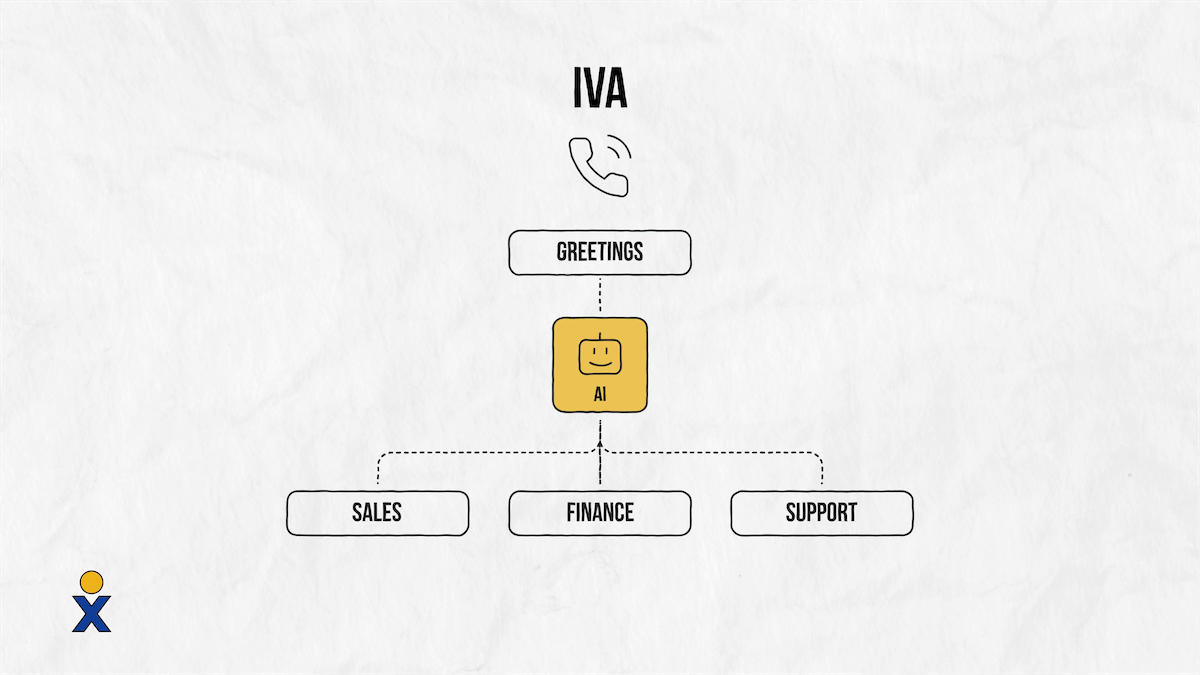
How to Create and Implement Intelligent Virtual Agents
Creating and implementing an intelligent virtual agent requires careful planning and preparation.
Here are some important steps:
- Define goals. Clearly define what you want to achieve with your IVA. Suggested goals include improving customer satisfaction, reducing customer service costs, or generating more leads.
- Choose the right platform. Choose an IVA platform that suits your needs and budget. There are numerous options available, from cloud-based solutions to on-premise deployments.
- Develop conversation flows. Design the conversation flows your IVA will use to interact with users. This includes creating a dialogue tree that shows a conversation’s different outcomes.
- Train the IVA. Train the IVA on a large dataset of text and audio recordings to improve its ability to understand natural language and respond appropriately.
- Monitor and refine. Continuously monitor the performance of your IVA and make adjustments as needed. This may include refining conversation flows, adding new features, or improving the IVA’s understanding of certain topics.
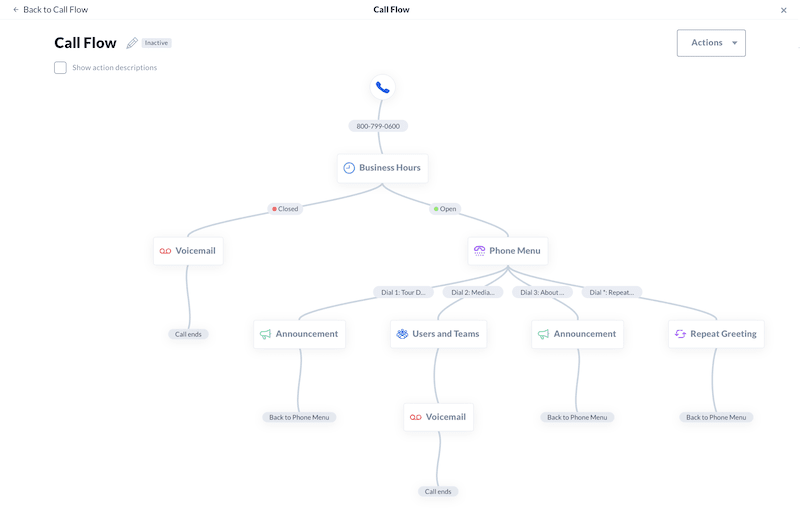
Challenges With Setting Up Intelligent Virtual Agents
Setting up intelligent virtual agents can be complex. You consider your organization’s needs, the resources available, and the capabilities of your team.
- Cost: One of the biggest challenges when setting up IVAs is cost. IVAs can be expensive to develop and maintain and require continued investment in training and data.
- Data quality: The quality of the data used to train IVAs is critical to their success. Intelligent virtual agents cannot provide accurate or helpful information if the data isn’t accurate or current.
- Integration: IVAs need to be integrated with other systems to be effective. This can be a complex and time-consuming process.
- Change management: The introduction of IVAs can represent a significant change for a company. Monitoring these changes carefully ensures staff and customers are comfortable using the IVAs.
- Skills: Setting up and managing IVAs requires a range of skills, including natural language processing, machine learning, and artificial intelligence. It’s important to have the right skills (and expert guidance) before launching an IVA project.
Despite these challenges, setting up IVAs offers several benefits. You just need to consider the challenges and plan around them.
- Start small: Don’t try to implement an IVA solution across the entire company at once. Start with a pilot to test the basics and see how it works.
- Get buy-in from stakeholders: Make sure everyone in the organization is on board with the IVA project.
- Use a phased approach: Break the IVA project into smaller, more manageable phases.
- Be patient: IVAs take time to develop and train. Don’t expect results overnight.
Creating an Intelligent Virtual Agent for Contact Centers
It’s harder to get started with a virtual agent. Instead of building one from scratch, there are tools available for you right now.
For example, Nextiva offers advanced IVR with conversational AI in contact center software that uses natural language processing to simplify customer interactions. Customers can express their concerns and quickly get the help they need.
The Nextiva IVR software enables you to provide individualized service, stay in constant contact with customers, and automatically align agent scheduling to match changing traffic patterns.
While IVAs can handle the basic tasks, self-service interactive voice response (IVR) handles large call volumes, freeing up your live agents to handle calls that require a more personal touch.
We will help you find the perfect virtual assistant for your company’s requirements.
Ready to give it a try? Talk with an expert to unlock more business growth with IVAs.



